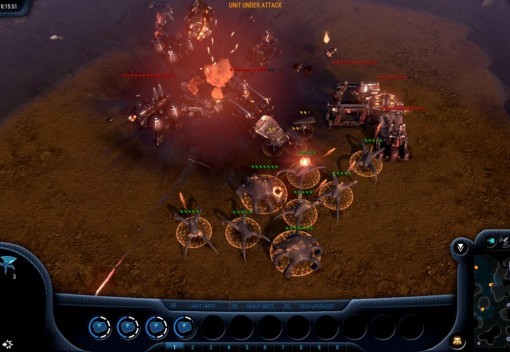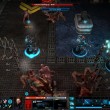Grey Goo Review
Retro in a good way. Modern-looking. And there you have Grey Goo, a back-to-the-future real-time strategy game from the Westwood veterans at Petroglyph. This is an impressive if deeply traditional game that is both a blast to play and a walk down memory lane for old timers who played Dune II and the first Command & Conquer in a time of parachute pants and high-waisted women’s jeans. Like every good homage, though, Grey Goo does not feel old or derivative, even while it blatantly draws on the influences of its antique forebears and current genre giants like StarCraft II. Shrewd map and scenario design, beautiful visuals, aggressive artificial intelligence, and more combine to make for a very challenging experience, no matter if you’re playing solo or multiplayer.
The sci-fi setting is a millennium or so into the future, a time when humanity has traveled into the stars and encountered two (apparently) alien races. The first is the Beta, a bipedal but vaguely insectoid (check out their nifty mandible-hand chest thingies) species that could have been ripped out of any one of a dozen old real-time-strategy affairs. But the second is the Grey Goo faction of the title, self-replicating nanobots that look like, well, piles of grey goo. The name comes from a well-known doomsday scenario wherein such microscopic machines run amok on Earth and consume the entire planet.
Unsurprisingly, these three species form the usual RTS triumvirate of factions. This trio is featured in a 15-mission campaign and four-player-max multiplayer/solo skirmishes on eight included maps, with three modes of play in Standard (destroy key enemy facilities), Annihilation (destroy all enemy facilities and units), and Destroy HQ (which should be self-explanatory). The game has been set up so that you must play through the campaign--which rolls out the Beta, then the Humans, then finally the Goo in five missions each--to learn enough about each faction to slide into multiplayer. Each section of the campaign plays out like an extended tutorial. You figure out the basics of the interface and base construction. You open up the whole list of buildings and units. You face varying objectives and a couple of seriously tough fights. Then you do the whole thing all over again with a different faction.
The Grey Goo campaign story is an interesting collection of fast-paced plot points, gorgeous cutscenes that look like excerpts from an animated sci-fi movie, and a sharp script coupled with first-rate voice acting (even if some of the accents are distracting, like the Beta who apparently come from deep space by way of Johannesburg). Everything held my interest, even though I could see the story twist coming a mile away.
Lack of mission variety and extreme difficulty proved more of a pain. Timed goals, waves of enemy attacks pressing my bases from the first moments of missions, and sudden challenges from new units firing down from hills and the air led to a bit of frustration and regular level replays. Enemy AI is smart and aggressive, probing weak points and continually hammering at defenses. Parts of the game are uncomfortably twitchy, forcing you to be quick with both combat and production orders, and many maps have a puzzle feel. I soon came to regard my first attempt at any campaign scenario as a suicide mission during which I needed to check out the battlefield. Gathering this reconnaissance info and then restarting was vital to having a reasonable shot at emerging victorious.
I didn’t need any recon missions to figure out the Grey Goo factions. The two humanoid types are quite familiar, differing mainly in how they construct their bases. Humans are standard techy types centered on robot drones, which run the gamut from little gunboat thingies and looming siege tanks to giant mechs. Base-building is centralized, with headquarters established near a pool of the game’s single Catalyst resource (think of it as a magic oil that flows out of the ground at various points on maps). This is gathered up via an automated system and then pumped out through power supply conduits that allow for the construction of the usual factories, walls, gun turrets, and so forth. As you might expect, these lines are vulnerable to attack. If connections are cut, the power goes down. Tech can help with cutting the cord to some structures, and the Humans can also teleport units across the map as well as build powerhouse gun turrets for base defense, but generally, the lines are your life.

Beta have a similar feel, although they are more hard-and-fast brawlers fairly similar to that in a modern human military. Units consist of commandos, tanks, bombers, and the like. Their bases are much more self-contained than those of their Human counterparts. Large facilities near Catalyst pools host the main HQ, while smaller hubs (which also generally need to be located beside Catalyst for ready collecting) allow multiple modules to be hooked up, serving as factories and the like to expand your reach. Both Beta and Humans also have roughly parallel upgrade paths and tech options, so once you have a handle on one, you can easily slide over and control the other.
Only the Goo greatly stand out. They function in an entirely different manner, which is emphasized by a completely different interface (which is fortunately just as easy to use as that applied to the Beta and the Humans). Giant, amoeba-like Mother Goo serve as bases. Just settle one into a pool of Catalyst and it will soak up the resource over time, allowing for mama to begin reproducing. The longer you wait, the bigger the offspring can be, resulting in smaller globs of nanobots that can then be further split to serve as scouts, light assault tanks, artillery, and so forth. This results in some micromanagement, as you need to click back and forth to your mothers whenever enough Catalyst has been gathered for them to do the mitosis thing. Thankfully, the interface makes this a snap, by showing the status of each mama and allowing you to access them and give orders with a single click.

New Mother Goos can also be created to take over other Catalyst ponds and spread out your zone of control. And the original mom can be moved from one pool to another, gradually sliming her way to the front lines. As a result, the Goo are more mobile than just about any other RTS faction out there (they can also go just about everywhere, traverse otherwise impassable mountains, and so forth). This offers a lot of tactical options, although I personally found that the Goo best worked with rush tactics due to their quick consumption of Catalyst and their rapid reproduction. I could crank out huge armies and overwhelm opponents in short order. Goo form is just as unusual, as their creepy units resemble a cross between the old B-movie Blob and slightly see-through space octopi. Disjointed, electronic sound effects accompanying their movement add to their surreal, sci-fi character.
Maps are cunningly put together with an eye toward encouraging tactical thinking. This offers significant challenges both in the solo campaign and in multiplayer. Catalyst resource pools are spread apart just far enough to make you think tactically before attempting any sort of expansion. This places importance on smart, sustainable base building. It also emphasizes the value of erecting walls and gun turrets to protect your facilities.
The visual quality of the maps is impressive. Everything looks fantastic, with an incredible amount of detail that also has a significant impact on combat. The drawback here is how the game pushes even serious gaming systems, resulting in regular framerate hitches and pauses when transitioning from pop-up screens like tutorial tips.
Still, what you get in terms of look and feel is worth it. Forests and heavy brush provide camouflage akin to flipping on a cloaking device. Height offers similarly incredible benefits. Both are a little over the top. Even tanks become invisible in trees. Aerial units and those atop cliffs and hills can’t even be fired upon by standard ground forces. But as much as I cursed when these strategies were used against me (that hill can’t be more than 20-feet high--why the hell can’t my commandoes shoot up there?!), I loved utilizing them myself as choke points, especially when setting up killing zones outside of bases. Just a few tanks stationed in the right place could decimate line after line of foes, letting me concentrate on other fronts.

Tactics are open, dependent on the ins and outs of the often puzzle-like map being battled over. Although I had success at times by turtling behind walls and building up Catalyst reserves with which to stream out huge armies, I also did well with rushing tactics when forced onto the offensive by aggressive AI or human players. A big help here is the absence of unit limits and the generally quick flow of building and tech progression that allows the zippy creation of masses of basic units such as the Beta Predator tank and the Goo Strider or Destructor.
Each faction also has an epic unit that can lay the smack down. I found cranking out swarms of the smaller units much more thrilling in that “I am become Death!” ego trip common to serving as an RTS general, due to the sheer fun of sending out columns of troops and tanks to cover the screen with laser fire. Still, it was also satisfying to fulfill the conditions necessary to let rip with the Beta’s super-tank/factory/cannon Hand of Ruk or the Human Alpha, a mech that could duke it out with Godzilla.
If you can get past the name to figure out what Grey Goo is supposed to be, you will discover one of the best traditional RTS games to hit the PC in a number of years. Petroglyph has done a terrific job both revisiting the tried-and-true formula that served as a foundation for the entire RTS genre, and providing catchy, tactically smart gameplay for the kids of the players who got everything going.









